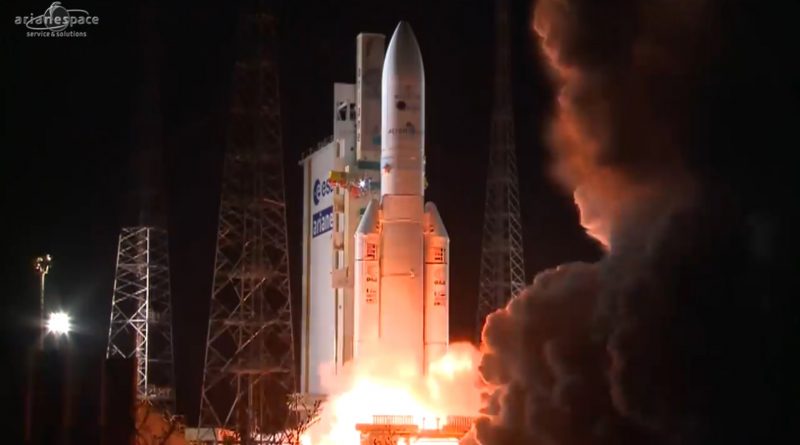Ariane 5 launches in the Dead of Night with High-Capacity Communications Satellite
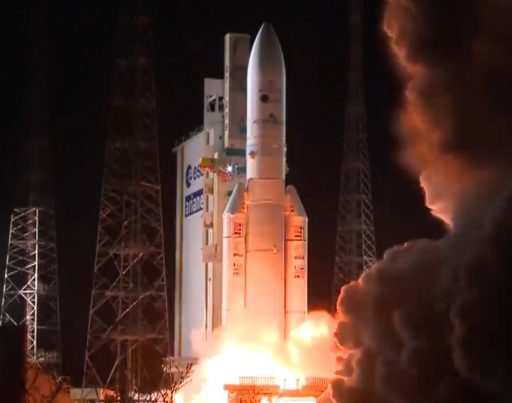
Europe’s Ariane 5 rocket made a middle-of-the-night liftoff on Wednesday, thundering into the dark skies over French Guiana headed due east for a trip to Geostationary Transfer Orbit. Riding solo under the large payload fairing of the Ariane 5 was the Eutelsat 65 West A satellite, in the second single-payload mission of the year flown by the European workhorse that typically transports a pair of satellites to their orbital destination.
Ariane 5 jumped off its launch pad at 5:20 UTC, powered by its core stage and twin Solid Rocket Boosters. Flying to the east, Ariane 5 separated its boosters a little over two minutes into the mission followed by the payload fairing, exposing the 6,600-Kilogram satellite for the rest of its ride into orbit. The second stage assumed control of the flight at the nine-minute mark for a burn of nearly 16 minutes to boost the satellite into a highly elliptical orbit, sent on its way 27 minutes after liftoff.
When Ariane had completed its primary mission, the ESC-A upper stage was planned to go through one-hour of in-orbit demonstrations involving the pressurization of tanks, coast flight testing and engine chilldown. These tests are performed to demonstrate the ESC-A/B can support extended missions with multiple engine burns and coast phases once the re-startable VINCI engine becomes operational for Ariane 6.
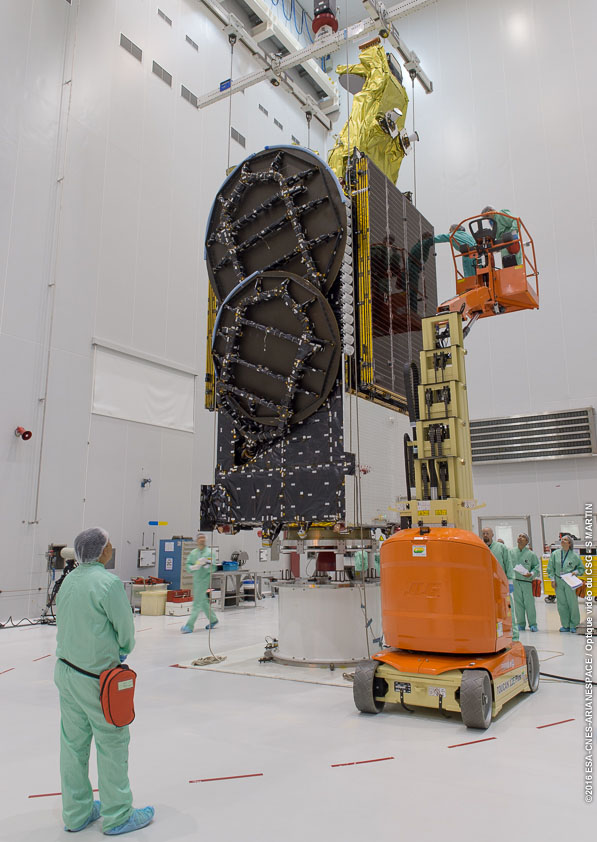
The Eutelsat 65 West A powerhouse is a high-capacity communications satellite, set to take up station at 65°W in Geostationary Orbit to provide TV and video distribution as well as high-speed broadband services to the Americas. Built by Space Systems/Loral, the satellite hosts a hybrid communications payload comprised of 10 high-powered C-Band transponders, 24 Ku-Band transponders and a Ka-Band payload generating 24 spotbeams. The C- and Ku-Band system will be used to deliver TV and video across coverage zones over the Americas, stretching as far as western Europe. The Ka-Band system will deliver high-throughput broadband over densely populated areas.
Eutelsat decided in October to foot the bill for an entire Ariane 5 rocket to bring forward the launch of Eutelsat 65 West A given some schedule pressure as the satellite is expected to be operational when the 2016 Olympics begin in Rio. Intelsat also placed one of the company’s satellites on a single-payload mission in January to avoid waiting for a co-passenger in the 3,000-Kilogram range to be ready for launch.
Typically, Ariane 5 launches one larger satellite weighing around 6,600kg riding atop a Sylda adapter that houses the smaller co-passenger, bringing Ariane’s total payload mass to over 10,000 Kilograms. In recent times, smaller satellites have become harder to find and larger spacecraft were faced with multi-month waiting periods. In order to keep to their schedule and revenue estimates for the year, both Intelsat and Eutelsat opted to go for solo missions on Ariane 5 instead of waiting and splitting the cost with another satellite operator.
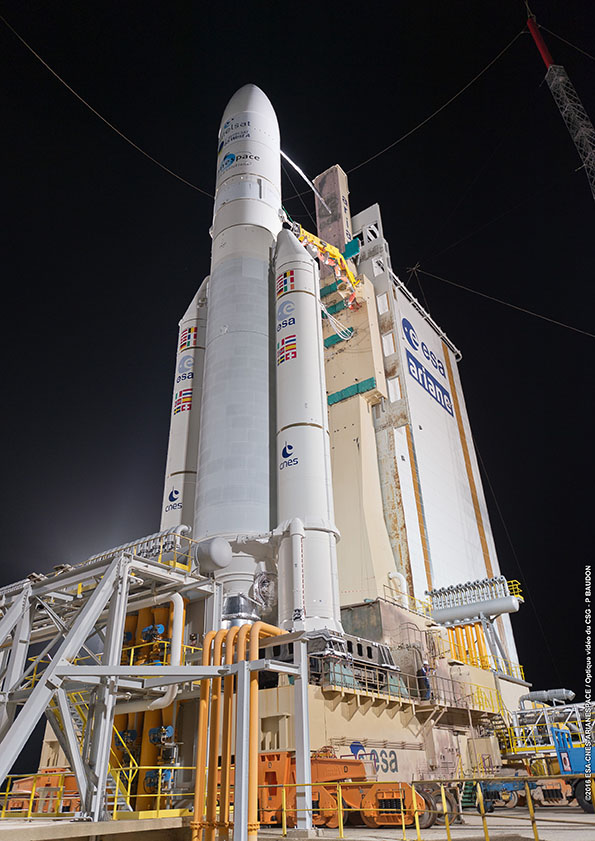
Carrying a light load of only one satellite enabled Ariane to leverage excess performance and deliver Eutelsat 65 West A to an optimized Geostationary Transfer Orbit with a reduced inclination. Eutelsat 65 West A was aiming for an orbit of 250 x 35,746 Kilometers at an inclination of 0.5° instead of a standard GTO of 250 x 35,786 Kilometers inclined 6° to which Ariane can deliver a pair of satellites. To achieve this low-inclination orbit, Ariane 5 was expected to use excess performance for an inclination-reduction by the second stage when flying over the Atlantic.
Having been moved to the launch pad on Monday, Ariane 5 headed into a lengthy countdown operation on Tuesday, 11 and a half hours prior to the opening of Wednesday’s three-hour launch window. Powered up at L-7.5 hours, Ariane 5 entered an extensive testing campaign while teams closed out the rocket on its pad as well as all ground facilities to clear the way for fueling.
Propellant loading started four hours ahead of liftoff with chilldown of transfer lines and tanks before the -183°C Liquid Oxygen and -253°C Liquid Hydrogen started flowing into the two-stage rocket. The core stage received 160 metric tons of cryogenics while the ESC-A upper stage was filled with 14,900 Kilograms of LOX and LH2.
Ariane 5, weighing in at 777 metric tons at liftoff, stands 53 meters tall and uses a two-stage stack with two Solid Rocket Boosters. The Core Stage is 30.5 meters tall and 5.4 meters in diameter powered by a Vulcain 2 main engine delivering 1,340 Kilonewtons of vacuum thrust. Sitting atop, the second stage is 4.7 meters long and hosts a single 62.7kN HM-7B engine.
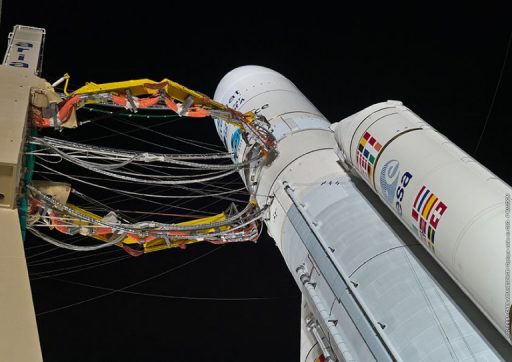
Propellant loading was by the book and Ariane 5 headed into the final preparatory steps for its Synchronized Countdown Sequence. In the minutes leading up to final status checks, Eutelsat 65 West A transferred to internal power to get ready for its ride into space. Ariane 5 finished engine chilldown, received an updated flight software and went through a final set of telemetry checks.
With a clean bill of health, Ariane 5 headed into the highly choreographed Synchronized Sequence to go through the last steps to transition to an autonomous configuration. The two-stage rocket was switched to internal power, armed its safety and pyrotechnic systems, and started pressurizing its tanks after ground propellant and pressurant feeds were terminated.
The engine was set up for ignition and Ariane 5 activated onboard recorders before the start of the ignition sequence was commanded at T-37 seconds. The last steps ahead of launch were the activation of the attitude control system, the pressurization of the POGO vibration dampening system and the retraction of the Cryogenic Feed Arms as well as the handover of control to Ariane’s onboard computers.
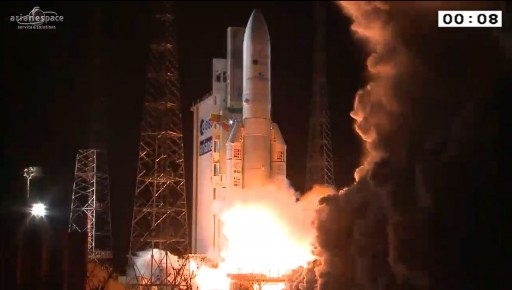
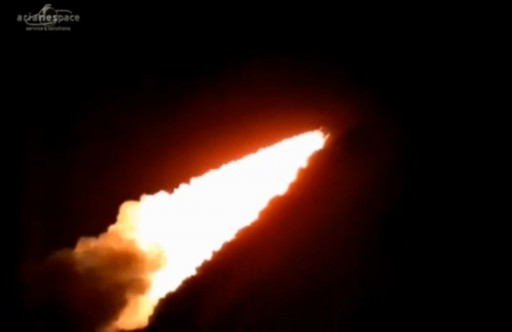
Ariane 5 came to life at 05:20:00 UTC when its Vulcain 2 engine started breathing fire, starting up and throttling to a liftoff thrust of 98 metric-ton-force. The ignition of the engine was monitored carefully before Ariane 5 was committed to flight, igniting its twin boosters.
The two Solid Rocket Boosters ignited at T+7.3 seconds and lifted Ariane 5 off the ground with a total thrust of 1,420 metric-ton-force – equivalent to ten Airbus A380s at full throttle. Rising from its equatorial launch pad, Ariane 5 lit up the night skies over French Guiana, climbing vertically for six seconds before pitching and rolling to attain its precisely planned ascent path to the east.
The two boosters generated 92% of the vehicle’s total thrust, quickly accelerating the Ariane 5. The rocket reached the speed of sound 49 seconds after liftoff and went through Maximum Dynamic Pressure just after passing one-minute into the flight, burning though 3,600 Kilograms of propellants each second of powered flight.
Helping accelerate the rocket to a speed of over two Kilometers per second, each of the twin boosters burned through 237,000 Kilograms of propellant. The EAP booster measures 31.6 meters in length and 3.05 meters in diameter, capable of delivering 6,470 Kilonewtons of thrust.
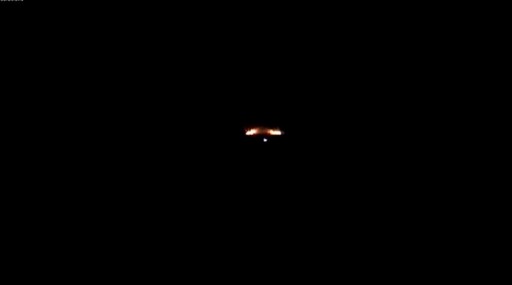
The two boosters burned out two minutes and 24 seconds into the flight, signaling thrust tail-off by their dropping chamber pressure. triggering the separation of the boosters. Separation of the boosters occurred 67 Kilometers in altitude using pyrotechnic systems and retrorockets to push the boosters away from the Core Stage, en-route to a splashdown in the Ocean.
Heading towards orbit, Ariane 5 was relying on the Vulcain 2 engine alone, burning 290 Kilograms of propellants per second to generate a thrust of 136,600 Kilogram-force when flying through the rarefied layers of the upper atmosphere.
Three minutes and 41 seconds into the flight, the 17-meter long payload fairing was jettisoned when the stack reached an altitude of 123 Kilometers. At that point, aerodynamic forces could no longer harm the satellites as the vehicle continued its ride into orbit.
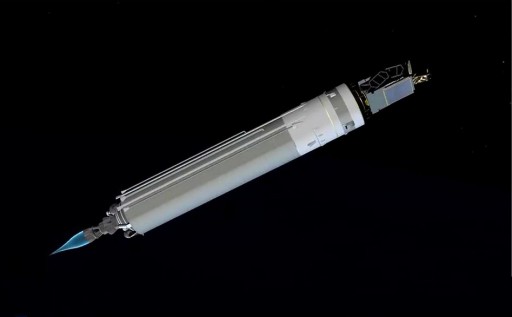
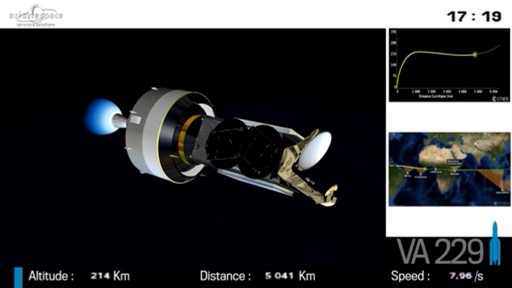
As the launcher headed downrange, the tracking station at Kourou lost the signal of the vehicle and downrange stations picked up the signal, first the Natal station, then the tracking station on Ascension Island followed by Libreville and lastly the Malindi station in Kenya that covered the final portion of the ascent all the way to insertion.
The Vulcain 2 engine of the first stage finished operation eight minutes and 49 seconds into the flight, lifting the stack in to a sub-orbital trajectory with a 231-Kilometer apogee and an inclination of 9.8°. Stage separation came seven seconds after MECO, using pyrotechnics and springs to move the spent Core Stage away from the ESC-A upper stage.
At T+8 minutes and 59 seconds, the HM-7B engine of the second stage soared up to a thrust of 6,400 Kilogram-force to finish boosting the stack into orbit. Over the course of a 15-minute and 38-second burn, the ESC-A stage was tasked with raising the apogee of the orbit to Geostationary Altitude and reducing the inclination by over nine degrees. ESC-A aimed for orbital insertion 552 Kilometers in altitude and a speed of 9.44 Kilometers per second.
This ascent trajectory was different from dual payload missions of Ariane 5 in which the first stage flies a slightly less-lofted trajectory, reaching an apogee around 160 Kilometers, but reducing the inclination to 7°. In Wednesday’s case, the second stage was tasked with a larger reduction in inclination by performing its burn slightly out of plane.
At the conclusion of the second stage burn, Ariane 5 headed into its ballistics phase, starting with the re-orientation for satellite separation right at T+25 minutes. Next was a transverse spin-up for satellite separation beginning one minute prior to spacecraft deploy.
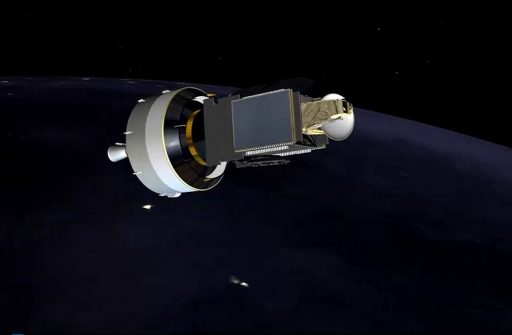
Eutelsat 65 West A was sent on its way 27 minutes after liftoff, embarking on its 15-year mission to deliver TV, video and data services to the Americas. The separation of the satellite marked the success of the VA229 mission, the 85th flight of the Ariane 5 and its 71st successful flight in a row.
After separation of the spacecraft, the ESC-A Upper Stage was tasked with avoidance maneuvers before beginning a one-hour demonstration as part of the DEMOFLIGHT program. This test procedure will be part of three Ariane 5 missions to gather engineering data from the second stage in preparation for the inauguration of the VINCI engine that will give the ESC-B stage re-start capability and lead to longer mission durations for the Ariane 6 launcher planned to make its debut in 2020.
DEMOFLIGHT begins with the self-pressurization of the ESC-A propellant tanks followed by a propellant settling maneuver by igniting the reaction control thrusters to deliver a small acceleration that causes the propellants to form a two-phase system to ensure the engine only receives liquid propellants without gas bubbles when being re-started. Propellant settling will continue for the third operation that occurs at T+39 minutes when the tanks will be pressurized with Helium. For that, the VA229 mission is carrying an additional Helium bottle on its second stage.
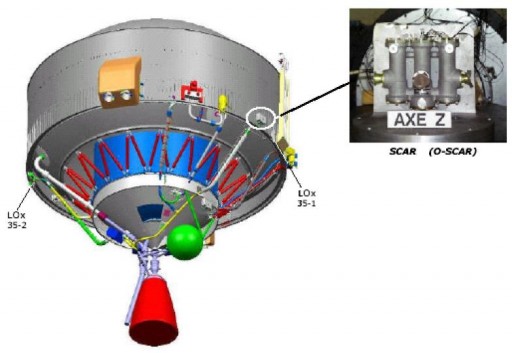
The HM-7B will complete an experimental chilldown 42 minutes after launch to demonstrate the behavior of the second stage when chilling down an engine for re-start. Next, the HM-7B will complete a perigee-decrease boost by opening the LOX valves to allow pressurized oxygen to escape through the engine nozzle and supply a small thrust component. The same will be done on the LH2 side a short time later and LOX/LH2 will complete a combined perigee-decrease boost. The final DEMOFLIGHT objective is flushing of the LOX dome at T+1 hour and 17 minutes.
When the DEMOFLIGHT objectives are complete, the upper stage will undergo passivation – spinning up to 45°/s and depressurizing all tanks to bring the VA229 mission to an end one hour and 31 minutes after liftoff.

